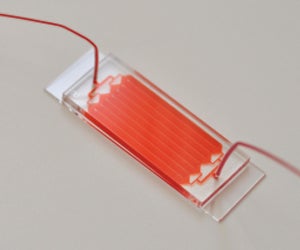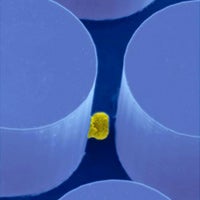
As Singularity Hub followers are well aware, it’s an exciting time in cancer screening. We’ve recently highlighted a number of new technologies that are in the works, such as Bio-Nano-Chips, a handheld microNMR detection system, and a tiny biomarker sensing implant, but these technologies are still early in their development cycle, and their future, though promising, is uncertain. However, one screening method that’s been around for five years has taken a big step toward becoming a viable kit for the clinic. Researchers at Massachusetts General Hospital Cancer Center (MGH) announced a $30 million, 5-year partnership with Johnson & Johnson to transform their cancer cell-detecting, microfluidic chip system into an easy-to-use liquid biopsy test. Dr. Daniel Haber, a lead researcher for the device, said, “We’re limited by our ability to make [a chip] fast, easy, cheap, and something that could be done on a global scale.”
Hopefully, that won’t be the case for long.
The story of this technology begins back in 2007 with a Nature paper and a NEJM article from Dr. Haber, Dr. Mehmet Toner, and colleagues at MGH reporting the breakthrough of a circulating tumor cell (CTC) device, dubbed the CTC-chip, that could selectively separate tumor cells from whole blood. This is a very needle-in-the-haystack problem since only one of the billion cells floating by will be a tumor cell. The CTC-chip was designed with 80,000 antibody-coated silicon columns within the microfluidic channels, so that proteins on the surface of passing tumor cells would bind to the antibodies as the blood flows through the channels. The researchers demonstrated that the method could isolate an average of 132 tumor cells from one milliliter of blood from patients with metastatic lung, prostate, pancreatic, breast and colon cancer. Furthermore, in a very small trial of patients receiving therapy for early-stage prostate cancer, the CTC-chip could be used to monitor patients’ response to anti-cancer treatment.

To really appreciate the promise of this technology, it’s important to recall that cancer is assessed in stages. Though a variety of staging systems exist for solid tumors, in general, lower stage cancer is localized and contained in the organ or tissue that the tumor develops within. Subsequent stages reflect more extensive tumor growth and the degree of its spread, especially to local lymph nodes. Finally the highest stage reflects the extensive spread of a tumor with cancerous cells breaking away and entering into blood and/or lymphatic vessels where they circulate to remote locations in the body. This is known as metastatic disease and is problematic not only because tumor cells are being carried everywhere, but tumors that develop are from their original cells. This means that tumors in the brain could be from cancerous breast or lung tissue, complicating treatment.
So in the studies with the CTC-chip, monitoring of tumor cells in the blood was essential in metastatic disease as a way of determining how many of these cells were in circulation, which could cause tumors to grow throughout the body. In the second trial, the amount of tumor cells in the blood could be correlated with treatment received, as a way of correlating decreases in circulating tumor cells with the effectiveness of a particular therapy. So not only could the cancerous cells be characterized, doctors could monitor how the disease was affected by the drugs that the patients received.
With a promising new technology that had potential for real cancer breakthroughs, the researchers assembled a Dream Team as part of the Stand Up to Cancer initiative launched by the Entertainment industry Foundation. The SU2C challenge is an exciting endeavor, not only because numerous celebrities are raising awareness about cancer research, but because the core of the challenge is collaboration, where scientists, researchers, and clinicians across a variety of disciplines are communicating and working cohesively to make big strides of progress. The CTC-Chip Dream Team brought together researchers at MIT, Memorial Sloan-Kettering Cancer Center, Dana-Farber Cancer Institute and M.D. Anderson Cancer Center. In 2009, the Team was awarded $15 million by the American Association of Cancer Research to support the CTC-chip development.
So now it’s two years later and the CTC-chip development has been moving along. However, each chip still costs about $500, and getting the chips out of research labs and into clinics remains a challenge. And this is where Johnson & Johnson comes in. The $30-million partnership between MGH researchers and two arms of Johnson & Johnson — Veridex, LLC, which produces their own CTC detection system, and Ortho Biotech Oncology R&D — is aimed at commercializing the device, which will involve finding a way to make it cheap and effective, and navigating through the regulatory passes and clinical trials required to get the chip to market. It’s a five-year partnership, which is hopefully a realistic timeframe for this technology to finally get into widespread use.
The CTC-chip story is an amazing and inspiring story because of the strides that collaborative, interdisciplinary research can make when players abandon the everyone-is-an-island approach to scientific and medical research. This story isn’t over, but fortunately organizations like Stand Up to Cancer are utilizing familiar faces in the entertainment industry to bring public awareness not only to the need for cancer research, but also to the individual researchers behind the scenes.
To see members of the MGH Dream Team and other cancer researchers talk about the power of collaboration, check out the following video, which is just one of the many that Stand Up to Cancer has produced:
[Images: Massachusetts General Hospital]
[SOURCE: Boston Globe, MGH, Nature, Nature Medicine, NCI, NEJM, Stand Up to Cancer]



